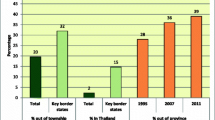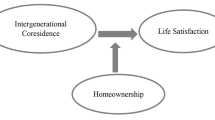Abstract
Despite the growing research on the living arrangements of elderly we know very little about intergenerational relations in Turkey. This research is a step towards this goal. The purpose is to assess whether urbanization and economic development at the aggregate level and modernity and secularism at the individual level result in a decline in coresiding and living nearby older family members in Turkey. Results obtained using multinomial logistic estimates are supportive of the hypotheses. There is a significant variation in coresidence and in the reasons for coresiding with older family members by regional development, urbanization, individual modernity and religiosity.
Similar content being viewed by others
References
Abadan-Unat, N. (1986). Women in the developing world: Evidence from Turkey. Denver, CO: University of Denver.
Acquilino, W. S. (1990). The likelihood of parent-adult child coresidence: Effects of family structure and parental characteristics, Journal of Marriage and the Family 52: 405–419.
Albert, S. M. & Cattell, M. G. (1994). Old age in global perspective: Cross-cultural and cross-national views. New York: G. K. Hall & Co.
Bressford, J. C. & Rivlin, A. M. (1966). Privacy, poverty and old age, Demography 3: 247–258.
Burch, T. K. & Matthews, B. J. (1987). Household formation in developed societies, Population and Development Review 13(3): 495–511.
Cagirici, M. (1992). Islam dusuncesinde aile ahlaki. In T. C. Basbakanlik Aile Arastirma Kurumu (ed.), Sosyo-Kulturel Degisme Surecinde Turk Ailesi, Vol. 1 (pp. 341–352).
Caldwell, J. C. (1980). Mass education as a determinant of the timing of fertility decline, Population and Development Review 6(2): 225–255.
Casterline, J. B., Williams, L., Hermalin, A., Chang, M. C., Chayovan, N., Cheung, P., Domingo, L., Knodel, J. & Ofstedal, M. B. (1991). Differences in the living arrangements of the elderly in four Asian countries: The interplay of constraints and preferences, Comparative Study of the Elderly in Asia, Research Reports No. 91–10. Population Studies Center, University of Michigan.
Casterline, J. B., Williams, L., Chang, M. C., Chayovan, N., Cheung, P. & Domingo, L. (1992). Living arrangements of the elderly in four Asian countries. Paper presented at the National Institute and Aging, Summer Institute in Aging, RAND, Santa Monica, California.
Casterline, J. B., Chang, M. C., Chayovan, N. & Domingo, L. (1993). The density of parentchild co-residence in East and Southeast Asia. Paper presented at the annual meetings of the Population Association of America, Cincinnati, Ohio.
Cowgill, D. O. & Holmes, L. D. (1972). Aging and modernization. New York: Meredith Corporation.
DaVanzo, J. & Chan, A. (1994). Living arrangements of older Malaysians: Who coresides with their adult children, Demography 31(1): 95–113.
Davis, K. & van den Oever, P. (1981). Age relations and public policy in advanced industrial societies, Population and Development Review 7(1): 1–18.
De Vos, S. (1990). Extended family living among older people in six Latin American countries, Journal of Gerontology: Social Sciences 45(3): S87–94.
De Vos, S. & Holden, K. (1988). Measures comparing living arrangements of the elderly: An assessment, Population and Development Review 14(4): 688–704.
Duben, A. (1982). The significance of family. In Kagitcibasi (ed.), Sex roles, family and community in Turkey (pp. 73–99). Bloomington: Indiana University, Turkish Studies.
Elman, C. & Uhlenberg, P. (1995). Co-residence in the early twentieth century: Elderly women in the United States and their children, Population Studies 49: 501–517.
Fox, G. L. (1975). Love match and arranged marriage in a modernizing nation: Mate selection in Ankara, Turkey, Journal of Marriage and Family 37: 180–193.
Gocek, M. & Schuman, H. (1993). Defining the boundaries of Islamic fundamentalism: The case of modern Turkey, A proposal submitted to National Science Foundation.
Hancioglu, A. (1993). Introduction. Demographic and health survey: Turkey. Hacettepe University, Institute of Population Studies.
Ilbas, Z. (1991). Aile - akrabalik iliskileri ve degismeler uzerine bir arastirma. Aile yazilari 2: Kulturel degerler ve sosyal degisme. Ankara: Aile Arastirma Kurumu Baskanligi Yayini.
Kandiyoti, D. (1977). Sex roles and social change: A comparative appraisal of Turkey's women, Signs 3: 57–73.
Lesthaeghe, R. & Surkyn, J. (1988). Cultural dynamics and economic theories of fertility, Population and Development Review 14(1): 1–45.
Magnarella, P. J. (1973). The reception of Swiss family law in Turkey, Anthropological Quarterly 46: 100–116.
Martin, G. L. (1989). Living arrangements of the elderly in Fiji, Korea, Malaysia, and the Philippines, Demography 26(4): 627–643.
Martin. G. L. (1990). Changing intergenerational family relations in East Asia, The Annals of the American Academy of Political and Social Science 510: 102–114.
Meric, U. (1991). Islamda aile. Aile yazilari 2: Kulturel degerler ve sosyal degisme (pp. 423–444). Ankara: Basbakanlik Aile Arastirma Kurumu.
Michael, R. T., Fuchs, V. & Scott, S. R. (1980). Changes in the propensity to live alone: 1950–1976, Demography 17: 39–56.
Mumcu, A. (1986). Tarih acisindan Turk devriminin temelleri ve gelisimi. Ankara: Inkilap Kitabevi.
Mutchler, J. E. & Burr, J. A. (1991). A longitudinal analysis of households and nonhousehold living arrangements in later life, Demography 28: 375–390.
Ofstedal, M. B. (1994). An application of the simultaneous logit model: Coresidence choices of elderly parents and adult children in Taiwan. Paper presented at the National Institute of Aging, Summer Institute in Aging, RAND, Santa Monica, California.
Ogawa, N. & Retherford, R. D. (1993). Care of the elderly in Japan: Changing norms and expectations, Journal of Marriage and the Family 55(3): 585–597.
Ozbay, F. (1990). Turkiye' de aile ve hane yapisi: Dun, bugun, yarin. Marmara Universitesi Iktisadi ve Idari Bilimler Fakultesi Dergisi. Cilt VII, Sayi 1–2.
Pampel, F. C. (1983). Changes in the propensity to live alone: Evidence from consecutive cross-sectional surveys, 1960–1976, Demography 20: 433–447.
Smelser, N. (1959). Social change and the industrial revolution. Chicago: University of Chicago Press.
Timur, S. (1972). Turkiye'de Aile Yapisi. Ankara: Hacettepe University. Turk Aile Yapisi Arastirmasi, 1992. Ankara: DPT, Sosyal Planlama Genel Mudurlugu, p. 64.
Thornton, A. & Fricke, T. (1987). Social change and the family: Comparative perspectives from the West, China, and south Asia, Sociological Forum 2(4): 746–779.
Toros, A. (1993). Fertility, In: Demographic and health survey: Turkey. Hacettepe University, Institute of Population Studies.
Turkdogan, O. (1992). Turk Ailesinin Genel Yapisi. In T. C. Basbakanlik Aile Arastirma Kurumu (ed.), Sosyo-Kulturel Degisme Surecinde Turk Ailesi, Vol. 1 (pp. 29–66).
Turkish Census of Population: Social and Economic Characteristics of Population (Genel Nufus Sayimi: Nufusun Sosyal ve Ekonomik Nitelikleri). 1985. T. C. Basbakanlik Devlet Istatistik Enstitusu.
Turkoz E., ed. (1985). Family in Turkish society: Sociological and legal studies (pp. 43–77). Ankara: Turkish Social Science Association.
Wolf, D. A. & Soldo, B. J. (1988). Household composition choices of older unmarried women, Demography 25(3): 387–403.
Yener, S. (1977). 1965–1970 doneminde iller arasi gocler ve goc edenlerin nitelikleri. Ankara: State Planning Organization Publication.
Author information
Authors and Affiliations
Rights and permissions
About this article
Cite this article
Autaç, I.A. Intergenerational living arrangements in Turkey. Journal of Cross-Cultural Gerontology 13, 241–264 (1998). https://doi.org/10.1023/A:1006546417674
Issue Date:
DOI: https://doi.org/10.1023/A:1006546417674




